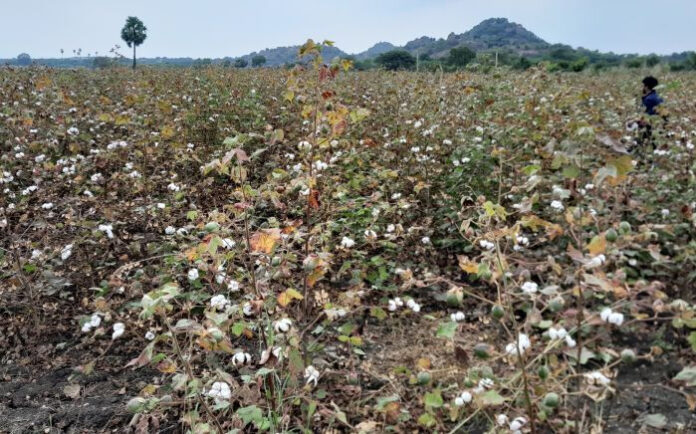In a move aimed at arresting the declining cotton production in India, the Union government plans to promote the shift of cotton cultivation from disease-infested fields to disease-free cultivatable and irrigated areas within Haryana, Rajasthan, Punjab, Maharashtra, and Telangana, according to two officials.
Shifting of cultivation means farmers in identified disease-free districts will be encouraged to change from conventional crops to cotton and those in infected areas would be motivated to shift to other crops.
The plan could double cotton production to 30 quintal per acre. This comes in the backdrop of cotton area, production and productivity registering a declining cotton production trend of 31.6 million bales in 2023-24 from 33.6 million bales in 2022-23.
In recent years, there has been a sharp decline in ‘white gold’ production, as per textile ministry data. Annual production in 2017-18 was 37 million bales (170 kg each) that fell to 33.3 million bales next year. After growth in 2019-20 (36.5 million bales), it slipped to 35.2 million bales in 2020-21 and 31.1 million in 2021-22.
The Indian Council of Agricultural Research (ICAR), the research arm of the agriculture ministry, is working on a proposal to promote shifting of cotton cultivation from pink bollworm affected areas to fields which are not yet infected by insects like pink bollworm, and whitefly.
In areas where cotton has been grown for an extended time, insects like pink bollworm and whitefly form a complex that infects all cotton crops grown in those specific regions, the official said.
“These insects significantly impact cotton production in almost every cotton-growing state. Shifting the crops will undoubtedly increase the yield,” the official added.
In Haryana and Punjab, the acreage of cotton has come down drastically due to attacks by pests as production fell to 1 million bales in 2022-23 from 2.65 million bales in 2019-20.
Similarly, in Punjab, production shrank to 4.44 lakh bales (2022-23) from 9.50 lakh bales in 2019-20, as stated in the state-wise data on the website of the textile commissioner’s office.
“In the case of Haryana, new areas such as Mahendragarh, Palwal, and Rewari have been identified for the shifting of crops from Sirsa, Hisar, Fatehabad, Jind, and others,” the second official said.
“Awareness programmes have also been planned in the states of Rajasthan, Maharashtra, Telangana, Gujarat, etc., to sensitize farmers about the benefits of crop shifting,” the official said.
The proposal further discusses reducing the sowing window from two months to one month and developing better-quality indigenous seeds, the officials said. Additionally, incentives for farmers shifting from conventional to newly explored areas will also be part of the plan.
“In comparison to hybrid seeds, indigenous varieties of cotton offer an assured yield and better quality. The fiber length ranges from 26-28 mm, making it suitable to meet the requirements of the domestic textile industry,” the official stressed. “This type of cotton is used for absorbent cotton and blending purposes.”
However, cotton farmers desire improved infrastructure in the newly explored areas before deciding to shift to a new location. Ganesh Nanote, a cotton grower from Maharashtra’s Vidarbha region, expressed, “The move is appreciable, provided we have access to skilled labor, water, electricity, and robust transportation facilities.”










